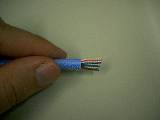
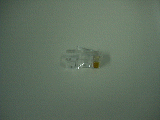
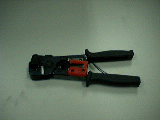
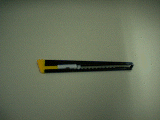
In Minoh lab, we always make UTP based LAN cables with the following instruction written by me. I don't know the instruction is formal or not, but at least it works well in Minoh lab.

| 
| 
| 
|
| UTP Category 5 cable | RJ45 Connector | Special Plier | Cutter |
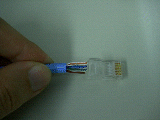
| 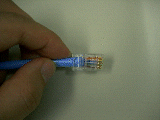
|
| Same order in the wire arrangement table | Insertion |
The tables below are for the case where the UTP cable consists of green/green-white, orange/orange-white, blue/blue-white, brown/brown-white twisted pairs.
| Pin ID | side A | side B |
| 1 | orange-white | orange-white |
| 2 | orange | orange |
| 3 | green-white | green-white |
| 4 | blue | blue |
| 5 | blue-white | blue-white |
| 6 | green | green |
| 7 | brown-white | brown-white |
| 8 | brown | brown |
| Pin ID | side A | side B |
| 1 | orange-white | green-white |
| 2 | orange | green |
| 3 | green-white | orange-white |
| 4 | blue | blue |
| 5 | blue-white | blue-white |
| 6 | green | orange |
| 7 | brown-white | brown-white |
| 8 | brown | brown |
You can use the straight cable for 10BaseT and 100BaseT as ATM straight cable because the pin arrangement is the same. (Actually, an ATM straight cable uses only 1,2,7,8 pins in 155Mbps mode, and 3,4,5,6 pins in 25Mbps mode. However, the straight cable of 10BaseT and 100BaseT is fully wired and so there is no problem.)
An ATM cross cable uses only 1,2,7,8 pins in 155Mbps mode, and 3,4,5,6 pins in 25Mbps mode.
Concerning CDDI cross cable, the pin arrangement of 1,2,7,8 pins are same as that of ATM cross cable, so you can divert CDDI cross cable for 155Mbps ATM cross cable (though I don't think you have it...)
| Pin ID | side A | side B |
| 1 | orange-white | brown-white |
| 2 | orange | brown |
| 3 | green-white | blue |
| 4 | blue | green-white |
| 5 | blue-white | green |
| 6 | green | blue-white |
| 7 | brown-white | orange-white |
| 8 | brown | orange |
| Pin ID | side A | side B |
| 1 | orange | brown |
| 2 | orange-white | brown-white |
| 3 | green | green |
| 4 | blue | blue |
| 5 | blue-white | blue-white |
| 6 | green-white | green-white |
| 7 | brown | orange |
| 8 | brown-white | orange-white |